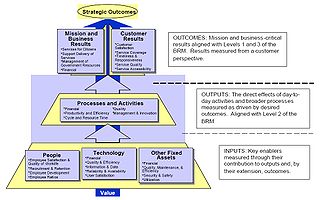
Knowledge management (KM) is the collection of methods relating to creating, sharing, using and managing the knowledge and information of an organization. It refers to a multidisciplinary approach to achieve organizational objectives by making the best use of knowledge.
Organizational learning is the process of creating, retaining, and transferring knowledge within an organization. An organization improves over time as it gains experience. From this experience, it is able to create knowledge. This knowledge is broad, covering any topic that could better an organization. Examples may include ways to increase production efficiency or to develop beneficial investor relations. Knowledge is created at four different units: individual, group, organizational, and inter organizational.

Job satisfaction, employee satisfaction or work satisfaction is a measure of workers' contentment with their job, whether they like the job or individual aspects or facets of jobs, such as nature of work or supervision. Job satisfaction can be measured in cognitive (evaluative), affective, and behavioral components. Researchers have also noted that job satisfaction measures vary in the extent to which they measure feelings about the job. or cognitions about the job.

A performance indicator or key performance indicator (KPI) is a type of performance measurement. KPIs evaluate the success of an organization or of a particular activity in which it engages. KPIs provide a focus for strategic and operational improvement, create an analytical basis for decision making and help focus attention on what matters most.

A business analyst (BA) is a person who processes, interprets and documents business processes, products, services and software through analysis of data. The role of a business analyst is to ensure business efficiency increases through their knowledge of both IT and business function.
Competence is the set of demonstrable characteristics and skills that enable and improve the efficiency or performance of a job. Competency is a series of knowledge, abilities, skills, experiences and behaviors, which leads to effective performance in an individual's activities. Competency is measurable and can be developed through training.

Performance measurement is the process of collecting, analyzing and/or reporting information regarding the performance of an individual, group, organization, system or component.
Greenberg (1987) introduced the concept of organizational justice with regard to how an employee judges the behavior of the organization and the employee's resulting attitude and behaviour. For example, if a firm makes redundant half of the workers, an employee may feel a sense of injustice with a resulting change in attitude and a drop in productivity.
Knowledge sharing is an activity through which knowledge is exchanged among people, friends, peers, families, communities, or within or between organizations. It bridges the individual and organizational knowledge, improving the absorptive and innovation capacity and thus leading to sustained competitive advantage of companies as well as individuals. Knowledge sharing is part of the knowledge management process.
BSC SWOT, or the Balanced Scorecard SWOT analysis, was introduced in 2001, by Lennart Norberg and Terry Brown.
Organizational behavior management (OBM) is a subdiscipline of applied behavior analysis (ABA), which is the application of behavior analytic principles and contingency management techniques to change behavior in organizational settings. Through these principles and assessment of behavior, OBM seeks to analyze and employ antecedent, influencing actions of an individual before the action occurs, and consequence, what happens as a result of someone's actions, interventions which influence behaviors linked to the mission and key objectives of the organization and its workers. Such interventions have proven effective through research in improving common organizational areas including employee productivity, delivery of feedback, safety, and overall morale of said organization.
Talent management (TM) is the anticipation of required human capital for an organization and the planning to meet those needs. The field has been growing in significance and gaining interest among practitioners as well as in the scholarly debate over the past 10 years, particularly after McKinsey's 1997 research and the 2001 book on The War for Talent. Although much of the previous research focused on private companies and organizations, TM is now also found in public organizations.
Business process management (BPM) is the discipline in which people use various methods to discover, model, analyze, measure, improve, optimize, and automate business processes. Any combination of methods used to manage a company's business processes is BPM. Processes can be structured and repeatable or unstructured and variable. Though not required, enabling technologies are often used with BPM.
Market intelligence (MI) is gathering and analyzing information relevant to a company's market - trends, competitor and customer monitoring. It is a subtype of competitive intelligence (CI), which is data and information gathered by companies that provide continuous insight into market trends such as competitors' and customers' values and preferences.
Counterproductive work behavior (CWB) is employee's behavior that goes against the legitimate interests of an organization. This behavior can harm the organization, other people within it, and other people and organizations outside it, including employers, other employees, suppliers, clients, patients and citizens. It has been proposed that a person-by-environment interaction (the relationship between a person's psychological and physical capacities and the demands placed on those capacities by the person's social and physical environment.) can be utilized to explain a variety of counterproductive behaviors. For instance, an employee who is high on trait anger is more likely to respond to a stressful incident at work with CWB.
Human resource planning is a process that identifies current and future human resources needs for an organization to achieve its goals. Human resource planning should serve as a link between human resource management and the overall strategic plan of an organization. Ageing workers population in most western countries and growing demands for qualified workers in developing economies have underscored the importance of effective human resource planning.
In organizational theory, organizational analysis or industrial analysis is the process of reviewing the development, work environment, personnel, and operation of a business or another type of association. This review is often performed in response to crisis, but may also be carried out as part of a demonstration project, in the process of taking a program to scale, or in the course of regular operations. Conducting a periodic detailed organizational analysis can be a useful way for management to identify problems or inefficiencies that have arisen in the organization but have yet to be addressed, and develop strategies for resolving them.
Responsible Research and Innovation (RRI) is a term used by the European Union's Framework Programmes to describe scientific research and technological development processes that take into account effects and potential impacts on the environment and society. It gained visibility around the year 2010, arising from predecessors including "ELSA" studies prompted by the Human Genome Project. Various slightly different definitions of RRI emerged, but all of them agree that societal challenges should be a primary focus of scientific research, and moreover they agree upon the methods by which that goal should be achieved. RRI involves holding research to high ethical standards, ensuring gender equality in the scientific community, investing policy-makers with the responsibility to avoid harmful effects of innovation, engaging the communities affected by innovation and ensuring that they have the knowledge necessary to understand the implications by furthering science education and Open Access. Organizations that adopted the RRI terminology include the Engineering and Physical Sciences Research Council.
Workplace democracy is the application of democracy in various forms to the workplace, such as voting systems, debates, democratic structuring, due process, adversarial process, and systems of appeal. It can be implemented in a variety of ways, depending on the size, culture, and other variables of an organization.
Personal initiative (PI) is self-starting and proactive behavior that overcomes barriers to achieve a goal. The concept was developed by Michael Frese and coworkers in the 1990s.






